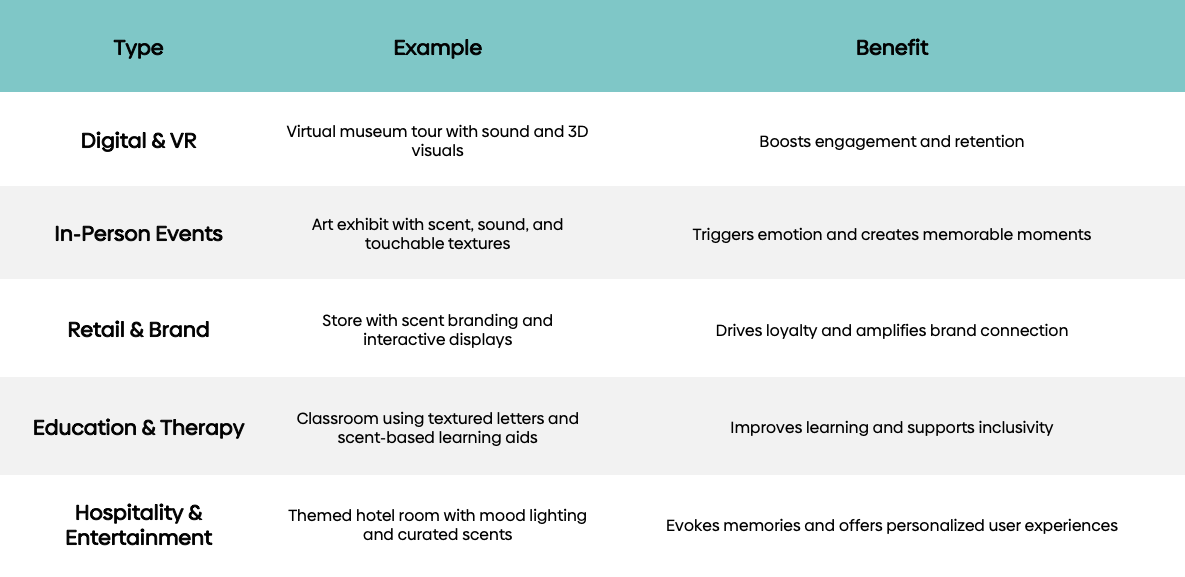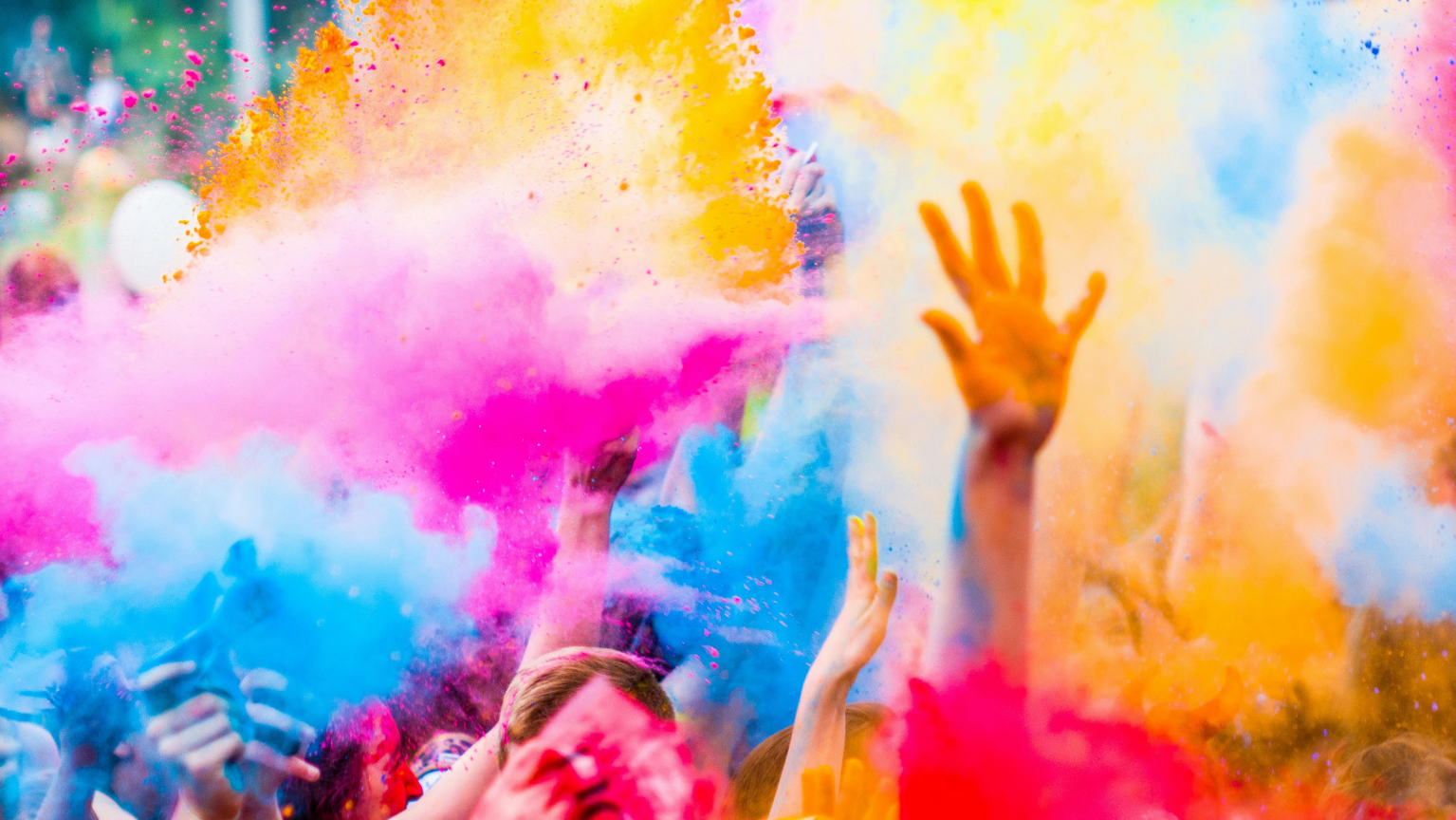Imagine walking into a room where the lights shift colors, soft music plays in the background, the air smells of fresh lavender, and textures invite your touch—suddenly, you're feeling it with all your senses.
Multisensory experiences in experience design refer to creating spaces or products that utilize more than one of our senses simultaneously, such as sight, sound, touch, taste, and smell. This helps people feel more involved, remember things better, and enjoy the experience more.
Since we understand the world through a mix of senses, using this approach makes experiences more powerful and engaging. This helps build richer and more memorable sensory experiences for users.
What is a Multisensory Experience?
A multisensory experience is a sophisticated interaction that engages multiple human senses simultaneously, aiming to create a more profound, immersive, and memorable experience.
This approach is grounded in the understanding that human perception is inherently multisensory; we constantly interpret and make sense of the world through the integration of visual, auditory, tactile, olfactory, and gustatory inputs.
- Vision (Sight): The perception of light, colors, shapes, and motion.
- Hearing (Auditory): The perception of sound, including tones, rhythms, and language.
- Touch (Tactile): The perception of physical contact, including texture, temperature, and pressure.
- Smell (Olfactory): The perception of scents and odors, which can evoke memories and emotions.
- Taste (Gustatory): The perception of flavors and substances on the tongue.
- Proprioception: The sense of body position and movement, contributing to how we perceive space and navigate environments.
- Vestibular Sense: The sense of balance and spatial orientation, important for movement and understanding our position relative to gravity.
Types of Multisensory Experiences

Top Examples of Multisensory Experiences
In the rapidly evolving landscape of design and technology, multisensory experiences have emerged as a powerful tool to captivate and engage audiences in unprecedented ways. From immersive art installations to interactive educational programs, the application of multisensory design principles is revolutionizing how we interact with our surroundings.
Below are some prominent examples that showcase the breadth and innovation of multisensory design in action.
Van Gogh Immersive Exhibitions
These exhibitions envelop visitors in the vibrant world of Vincent Van Gogh through large-scale projections, music, and sometimes scents, transforming his iconic paintings into a dynamic, encompassing environment.
Sensorial Restaurants
Places like Ultraviolet in Shanghai offer a dining experience where each course is accompanied by specific visuals, sounds, and scents, designed to enhance the flavor and overall dining experience.
Interactive Museums
The Museum of Ice Cream or the Color Factory invite visitors to engage all their senses through tactile exhibits, visually stunning rooms, edible treats, and scented installations, making for an unforgettable exploratory experience.
Educational VR Experiences
Virtual Reality (VR) platforms that simulate historical events or scientific phenomena, combining visual, auditory, and sometimes haptic feedback to create a deeply immersive learning environment.
Multi-sensory Art Exhibition
Multisensory elements have increasingly become a significant aspect of art exhibitions, offering a profound depth to the exploration of artistic expression and viewer engagement. By incorporating various sensory stimuli, artists and curators can transcend traditional visual boundaries, creating immersive environments that invite viewers to experience art in a holistic manner.
This approach not only enhances the aesthetic appeal of the artwork but also fosters a deeper emotional and cognitive connection with the audience.
How Do Multisensory Experiences Impact Learning?
Learning becomes a full-body experience as it engages multiple senses simultaneously, rather than just reading words on a page.
Instead of passively absorbing information, learners become active participants—seeing, hearing, touching, and sometimes even tasting or smelling concepts brought to life.
This sensorially balanced approach not only enhances user engagement and memory retention but also improves learning outcomes across diverse settings.
In fact, research shows that fifth-grade students who had a multisensory learning experience significantly improved their listening skills and comprehension. Students remembered themes, followed plots more easily, and expressed deeper emotional reactions to stories.
Multisensory learning stimulates sensory input in ways that trigger emotional responses and amplify sensory awareness: key factors in how our brains store and recall knowledge.
Take Maya, for example, a student who struggled with the concept of the water cycle. She didn’t understand the lesson until her teacher introduced a hands-on experiment.
Here, Maya was able to:
- Watch steam rise from a boiling pot (sight)
- Feel the warmth (touch)
- Hear the bubbling water (sound)
- Smell the change in the air (smell)
That simple, multisensory demonstration helped everything click.
Multisensory learning is applied in education, hospitality, and retail to create emotional and memorable connections. This memory-enhancing multimodal approach supports inclusivity in design by meeting diverse learning needs, including those of students with dyslexia, helping them evoke memories through sensory cues.
Important Factors in Creating a Multisensory Experience
Designing multisensory experiences is a complex, nuanced process that requires a deep understanding of how individuals perceive and interact with their environments. It involves more than just combining sights, sounds, and other sensory inputs; it's about creating a cohesive, immersive experience that engages users in a meaningful way.
Accessibility
Ensuring accessibility in multisensory experiences is crucial for creating inclusive environments where individuals with disabilities can equally participate and enjoy the full spectrum of the experience. Accessibility in this context goes beyond mere physical access to encompass the full engagement of all senses in a way that accommodates various disabilities.
Cultural Sensitivity
Cultural sensitivity in designing multisensory experiences is essential for creating environments that are respectful, inclusive, and engaging for people from diverse cultural backgrounds. This consideration ensures that the experiences do not inadvertently perpetuate stereotypes, offend, or exclude individuals based on cultural differences.
By acknowledging and integrating the vast array of cultural norms, values, and preferences, designers can craft experiences that resonate on a global scale, fostering a sense of belonging and appreciation among all participants.
Cost and Complexity
The creation of multisensory experiences poses significant challenges in terms of cost and complexity, particularly as designers strive to craft environments that engage multiple senses in a cohesive and impactful way.
The integration of various sensory elements—ranging from advanced technological installations to meticulously curated scents and tastes—requires not only a diverse skill set among the design team but also a substantial investment in materials, technology, and content development.
Technological Constraints
Technological limitations can significantly impact the creation and execution of multisensory experiences, potentially restricting the scope of sensory engagement or the overall quality of the experience.
From the availability of cutting-edge equipment to the integration of various technologies, designers often face hurdles in realizing their vision for a truly immersive environment. These constraints can stem from budgetary limits, the current state of technology, or compatibility issues between different systems and platforms.
Sustainability
Sustainability has become an increasingly crucial consideration in multisensory experience design, reflecting a broader societal shift towards environmental responsibility and ethical practices.
The integration of multiple sensory elements—ranging from digital displays to physical installations—often requires substantial resources, including energy consumption, materials, and waste production. As such, designers and creators are challenged to balance the immersive and engaging qualities of these experiences with the imperative to minimize their environmental footprint.
Ethical Considerations
The design of multisensory experiences involves a range of ethical considerations that extend beyond mere compliance with laws and regulations.
These considerations are rooted in the responsibility to respect the dignity, rights, and well-being of all participants, ensuring that experiences are not only accessible and inclusive but also mindful of privacy, consent, and cultural sensitivity.
Key Takeaways
- Multisensory Integration Enhances Engagement: Engaging multiple senses simultaneously in experience design significantly enhances user engagement, memory retention, and overall satisfaction, leveraging the integrated nature of human perception.
- Diverse Applications and Innovations: Multisensory experiences have been innovatively applied across various fields, including immersive art exhibitions, sensorial restaurants, interactive museums, and educational VR experiences, showcasing the breadth and potential of multisensory design.
- Complex Design Considerations: Creating multisensory experiences requires careful consideration of accessibility, cultural sensitivity, cost, technological constraints, sustainability, and ethical practices, underscoring the complexity and nuanced nature of the design process.
- Commitment to Inclusivity and Sustainability: Ensuring accessibility for individuals with disabilities and adopting sustainable practices are crucial for creating inclusive and environmentally responsible multisensory environments, reflecting a commitment to broader societal values.
Frequently Asked Questions
Is a Multisensory Experience More Effective Than Single-Sensory Design?
Yes. Multisensory experiences are more effective than single-sensory designs because they engage multiple senses, increasing memory retention, emotional impact, and user engagement. In contrast, single-sensory designs often lack depth, resulting in lower attention and less immersive interaction.
Is it Possible to Create a Multisensory Experience Online?
Yes. You can create a multisensory experience online using tools like virtual reality websites, interactive audio-visual content, and gamified learning platforms. These formats stimulate sight, sound, and touch (via haptic feedback), enhancing engagement and learning outcomes in digital environments.
Is There a Risk of Sensory Overload In Multisensory Experiences?
Yes. Sensory overload can occur when too many intense stimuli, such as loud sounds, flashing visuals, and crowded layouts, are combined. This overwhelms the brain, reduces comprehension, and can lead to discomfort or disengagement, especially in poorly designed environments.












